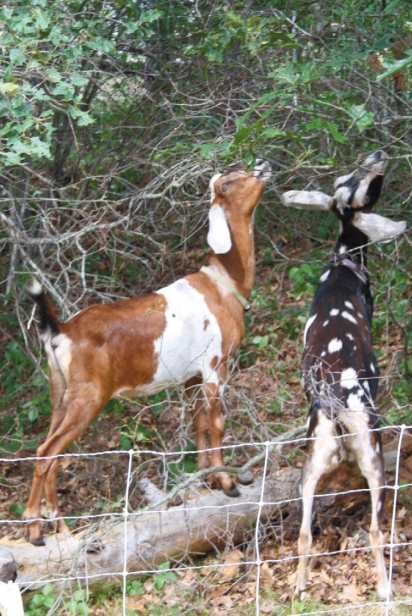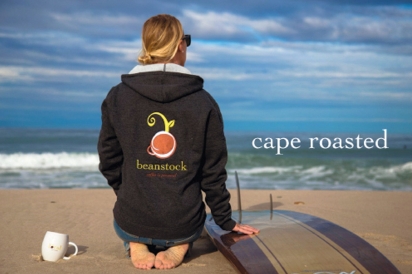GOat Green Cape Cod
The enemies are at the gate . . . and the arbor, the trellis and the garden. The insidious creep of invasive nuisance plants affects us all, and far too many of us reach for that little bottle of highly toxic ____-ocide to kill off our problems. There are all-natural, organic products that may not be as effective, but certainly these alternatives are far less harmful to the environment. There is a third way to handle those infuriating poison ivy, bittersweet and bull briar plants. One that is, by far, the most efficient solution and the one that’s least harmful to the environment. In fact, you couldn’t get any more environmentally friendly than releasing a herd of goats to fight your battle for you. GOat Green Cape Cod is at your service to provide your very own army to chomp through all those weeds.
In 2014, Stacey Greaves rescued four goats from a farm in Chester, Massachusetts. “I wanted goats, but they needed to be selfsustaining,” she said. A year later, they were not only self-sustaining, but thriving, as GOat Green Cape Cod launched to deliver a unique way to solve an all-too-familiar problem. GOat Green Cape Cod now has two six-goat teams that spend up to a week or longer on a property. Herds any larger could be problematic, because goats are competitive eaters (picture Joey Chestnut and Kobayashi brawling on stage at the Nathan’s hot dog eating contest). From sunrise to sunset, the goats eat their way through the weeds and brush that encroach and choke out indigenous plants. Reaching branches as high as six feet off the ground, the goats consume up to three times their weight in a single day! Fertilizing the soil as they go further helps re-establish a healthier ecosystem. The only plants the goats can’t eat are rhododendrons and azaleas. “Plants in the rhododendron family are highly toxic to the goats,” Greaves points out.
A lot of travel and work go into leaving a herd behind for a week. Greaves needs to make several visits to a client’s home. The first is a site visit for an inspection, paperwork, and educating the homeowner on the electric fence used to pen in the goats. Then, a return visit takes place to set up the electric fence and temporary shelter, followed by a third trip to deliver the goats. Trudging through the undergrowth and clearing a path for the fence can take hours, far too long for the goats to wait in the converted van Greaves uses to transport them. While the goats are on site, Greaves is in frequent contact with the property owner.
The client is responsible for maintaining a supply of water, grain and minerals (which GOat Green Cape Cod leaves on site) for the munching minions, and making sure no one has escaped. It does happen from time to time, but this is no prison break. Being social animals, the absconding goat never seems to roam far from the herd. “Leland is my escape artist,” Greaves chuckles. “But he stays just outside the fence next to everybody else.” Perhaps the grass (and poison ivy, autumn olive, etc.) is always greener on the other side of the fence, even in the goat world.
Residential and commercial properties, schools and conservation commissions all benefit from these voracious little billies. The types of clients are as varied as the reasons they have for using goats to control the vegetative growth. One client chose the goats over heavy equipment so as not to disturb the osprey nest within the area of undergrowth. A group commissioned a GOat Green team to help reclaim an old cranberry bog. The little cloven-hoofed herbivores not only gobbled up the offending greens, but left the cranberry vines intact. One homeowner couldn’t get to the blueberry bushes because of all the poison ivy. Gus, Midnight and crew took care of the ivy, along with the blueberries, allowing the blueberries to come back the next year without the ivy interfering with the homeowner’s harvest.
Some of Greaves’ favorite clients are grandparents. “They love the concept, and teaching the grandkids about the goats,” she smiles. It’s an eye-opening experience for all, as neighbors will stop by to see the goats in action. Some clients love the goats and the job they do so much, they call GOat Green Cape Cod back two and even three times to tackle more areas of their property. In between gigs, the goats are eaters-in-residence at Mass Audubon’s Long Pasture Wildlife Sanctuary in Cummaquid.
Moving two separate herds of goats, with all that it entails, is more than one person can manage. Greaves has enlisted her stepsister and her husband, Tina and Ben Harrick, along with Steve Cory, to help with the large amount of work for this small business. The next step, as business grows, is to purchase or lease barn space for a permanent residence for the goats when not out on a job. There’s certainly no shortage in the labor pool. “I get texts and e-mails daily about taking in goats,” Greaves claims. The demand is there, as well. The waiting list gets longer with each passing year.
Perhaps you can plan a GOat Green Cape Cod visit to coincide with the next family incursion. It’ll take care of that nasty thorny brush in the most environmentally friendly way possible, and you’ll be able to extract yourself from a thorny family “discussion” in the most family friendly way possible. GOat Green Cape Cod . . . solving many of the invasive problems that can arise in the summer on Cape Cod.







